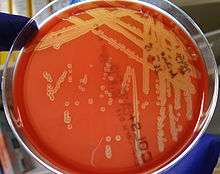Arcanobacterium haemolyticum
| Arcanobacterium | |
|---|---|
 | |
| Arcanobacterium haemolyticum colonies on a blood agar plate: Beta-hemolysis is demonstrated with transmitted light. | |
| Scientific classification | |
| Kingdom: | Bacteria |
| Phylum: | Actinobacteria |
| Class: | Actinobacteria |
| Order: | Actinomycetales |
| Family: | Actinomycetaceae |
| Genus: | Arcanobacterium |
| Species: | A. haemolyticum |
Arcanobacterium haemolyticum, formerly known as Corynebacterium hæmolyticum, is a species of bacteria classified as a gram-positive bacillus. It is catalase-negative, aerobic, beta-hemolytic, and not motile.[1] It is part of the normal flora of the pharynx, but it may sometimes cause head and neck infections, pharyngitis, and sinusitis[1] (Arcanobacterium haemolyticum infections).
History
It was first described by MacClean et al. in 1946 from US servicemen and peoples of the South Pacific suffering from sore throat.[2] Due to its resemblance to another genus of bacteria, Corynebacterium, A. haemolyticum was initially classified as C. pyogenes subspecies hominus.[3] It was known for several decades as Corynebacterium haemolyticum; controversies regarding classification were resolved in 1982 when a new genus, Arcanobacterium, was created by Collins et al.[4][5] to reclassify Corynebacterium haemolyticum on the basis of its peptidoglycan, fatty acid, and DNA characteristics.
Since its initial description, the spectrum of diseases caused by A. haemolyticum has been expanded to include sepsis and osteomyelitis. Organisms are Gram-positive,[6] facultative anaerobic, catalase-negative rods (but transition to the coccal shape occurs as the organism grows) with arrangements described as matchbox or Chinese letters arrangements. Growth is enhanced in blood and by carbon dioxide.
Detection
Hemolysis is detected on human blood agar plates, and routine plating of specimens suspected of containing A. haemolyticum on human blood agar is suggested to distinguish it from Streptococcus pyogenes, as A. haemolyticum can easily be confused with this organism. Microscopic morphology differences can be used to differentiate them, since Arcanobacterium is rod-shaped and Streptococcus is coccus-shaped.[7]
A. haemolyticum infection is most common in 15- to 25-year-old persons and manifests as exudative pharyngitis and/or tonsillitis accompanied by cervical lymphadenopathy. Symptoms look like those of β-hemolytic streptococci or viral infection. A rash of the chest and of the abdomen, neck, or extremities is seen in 20% to 25% of cases, enhancing the risk of diagnostic error as streptococcal infection or penicillin allergy, when β-lactam therapy is initiated without exact diagnosis.[8]
A. haemolyticum often occurs in polymicrobic infections together with typical respiratory pathogens such as streptococci. The isolation of classical pathogens from specimens that also contain A. haemolyticum might be in part responsible for the tendency to miss the organism.
Pathology
A. haemolyticum is the cause of pharyngitis (sore throat) in up to 2.5% of cases.[9] In one study, it was the causative agent of pharyngitis in 1.4% of military conscripts.[10] It is rarely found in the skin or throat of healthy people, meaning it is not a member of the usual bacterial flora.[3]
Little is known about the means by which A. haemolyticum causes infection or the associated skin manifestations. The organism is known to produce uncharacterized hemolytic agent(s), a neuraminidase and a phospholipase D (PLD) acting preferentially on sphingomyelin. PLD is known to result in tissue damage, but the role in disease of the cytotoxic effect caused by this extracellular toxin is not established.
Pyothorax has been reported.[11]
Treatment
A. haemolyticum isolated from humans is susceptible to erythromycin[12] (proposed as the first-line drug), clindamycin, gentamicin, and cephalosporins.
The use of parenteral antimicrobial drugs must be limited to serious infections.
See also
References
- 1 2 Volante M, Corina L, Contucci AM, Calò L, Artuso A (2008). "Arcanobacterium haemolyticum: two case reports". Acta Otorhinolaryngol Ital. 28: 144–6. PMC 2644988
 . PMID 18646577.
. PMID 18646577. - ↑ MacLean PD, Liebow AA, Rosenberg AA (1946). "A hemolytic Corynebacterium resembling Corynebacterium ovis and Corynebacterium pyogenes in man". J Infect Dis. 79: 69–90. doi:10.1093/infdis/79.1.69.
- 1 2 Linder R (1997). "Rhodococcus equi and Arcanobacterium haemolyticum: two "coryneform" bacteria increasingly recognized as agents of human infection". Emerging Infect. Dis. 3 (2): 145–53. doi:10.3201/eid0302.970207. PMC 2627624
 . PMID 9204295.
. PMID 9204295. - ↑ Collins, MD; Jones, D; Schofield, GM (1982), "Reclassification of 'Corynebacterium haemolyticum' (MacLean, Liebow & Rosenberg) in the genus Arcanobacterium gen.nov. as Arcanobacterium haemolyticum nom.rev., comb.nov.", J Gen Microbiol, 128 (6): 1279–1281, doi:10.1099/00221287-128-6-1279, PMID 7119737.
- ↑ Collins, MD; et al. (1982), "Chemical studies as a guide to the classification of Corynebacterium pyogenes and "Corynebacterium haemolyticum"", J Gen Microbiol, 128 (2): 335–341, doi:10.1099/00221287-128-2-335, PMID 7077293.
- ↑ "Arcanobacterium Haemolyticum: Overview - eMedicine". Archived from the original on 29 December 2008. Retrieved 2008-12-11.
- ↑ "Archived copy". Archived from the original on 2014-11-07. Retrieved 2014-11-06.
- ↑ "EID V3 N2: Rhodococcus equi and Arcanobacterium haemolyticum: Two Coryneform Bacteria Increasingly Recognized as Agents of Human Infection". Archived from the original on 27 September 2008. Retrieved 2008-11-04.
- ↑ Mackenzie A, Fuite LA, Chan FT, King J, Allen U, MacDonald N, Diaz-Mitoma F (1995). "Incidence and pathogenicity of Arcanobacterium haemolyticum during a 2-year study in Ottawa". Clin Infect Dis. 21 (1): 177–81. doi:10.1093/clinids/21.1.177.
- ↑ Carlson P, Kontianinen S, Renkonen OV, Sivonen A, Vorpi R Arcanobacterium haemolyticum and streptococcal pharyngitis in army conscripts Scand J Infect Dis. 1995; 27 (1) 17–8
- ↑ Parija SC, Kaliaperumal V, Kumar SV, Sujatha S, Babu V, Balu V (2005). "Arcanobacterium haemolyticum associated with pyothorax: case report". BMC infectious diseases. 5: 68. doi:10.1186/1471-2334-5-68. PMC 1236925
 . PMID 16144543.
. PMID 16144543. - ↑ Malini A, Deepa EK, Manohar PV, Borappa K, Prasad SR (2008). "Soft tissue infections with Arcanobacterium haemolyticum: report of three cases". Indian J Med Microbiol. 26 (2): 192–5. doi:10.4103/0255-0857.40543. PMID 18445965.